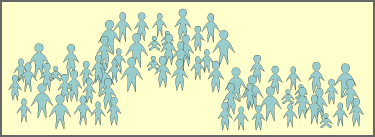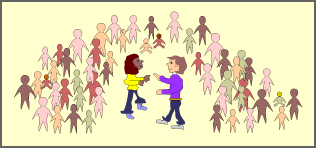

 TUTORIAL: SELF AND SOCIETY
TUTORIAL: SELF AND SOCIETYINTRODUCTION . SELF . SOCIETY . SUBGROUPS . SOCIETY AND SELF .
Imagine all of the people in the world:

One of the things that these people have in common is that they spend quite a bit of time communicating with one another. But on closer look, it turns out that all people don't communicate equally well with all others.
In fact, scholars are able to distinguish specific groups of people who tend to communicate among themselves much more often than with members of other groups. Furthermore, each of the groups tends to develop its own unique set of languages, values, and beliefs. Such groups are termed "societies".

Clearly, the study of human communication must occur within the context of human societies, and by taking this point of view, scholars have discovered that communication helps to establish the way of life of the people in each society, and in particular:
We observe that societies are distinguishable from one another in various ways. For example, Japanese society is usually seen (by Americans) as highly communal while American society is usually seen (by Americans) as highly individualistic. Americans see both French and Japanese societies as materialistic, while Chinese society is usually seen as much less so. The French are seen as characteristically focused on food, fashion, and art - the British on commerce and industry - the Hindu on spirituality - and so on.
This implies that certain ideas, values, traditions and the like are shared by the members of one society but not others, or that some are more important in some societies than they are in others. We call these shared elements the culture of a society.
Of course these cultural characteristics do not necessarily apply to individuals within the society. Certainly there are communal Americans, materialistic Chinese and industrious French. It is important to see that when we take the societal point of view, we are not speaking of individuals but of the collective way of life of the group. Within a society communication acts to strengthen certain characteristics and lessen others. This is an interesting idea, and we will devote a later chapter of this book entirely to the subject of culture.
Communication among societies is difficult because the very differences that make the societies distinct -- languages, customs, meanings -- make the connection between sender and receiver difficult to establish. This, too, will be discussed at length in chapters to come.
We definitely believe that past societies such as the Roman, or Mayan, or Assyrian existed for long periods of time. Similarly, some current societies, such as the Chinese, or the Hindu, are believed to have existed for many centuries. This implies that the culture of a society is maintained through the participation of its members, and in some way preserved over the centuries. For a society to survive, its members must cooperate in this participation. A society whose members are in conflict will eventually change into a different society or disappear entirely. In later chapters we will also investigate the role of cooperation in the human communication process as well as the role of communication in maintaining the cooperative existence of societies.
Societies often contain many smaller groups, some of which may contain
even smaller groups, and so on. Communication takes on different aspects
within these different groups. Here are some examples of such "sub-groups":
![]() 9517
9517
If we study a particular subgroup, we will find that it, too, contains
subgroups. For example, a family may contain such as parents, children,
grandparents, and distant relatives. Each of these subgroups will possess
certain cultural characteristics and patterns of communication. A bit of
thought will show that if scholars continued to break groups into subgroups, they
eventually would find themselves studying communication among individuals -- and thus would have come full circle.
![]() 9513
9513
![]() 9514
9514

The result of these observations is that we find ourselves unable to
say that the individual is more important to the study of communication than
the group, or vice-versa - the two are inseparable.
![]() 9508
9508
![]() 9515
9515
![]() 9516
9516